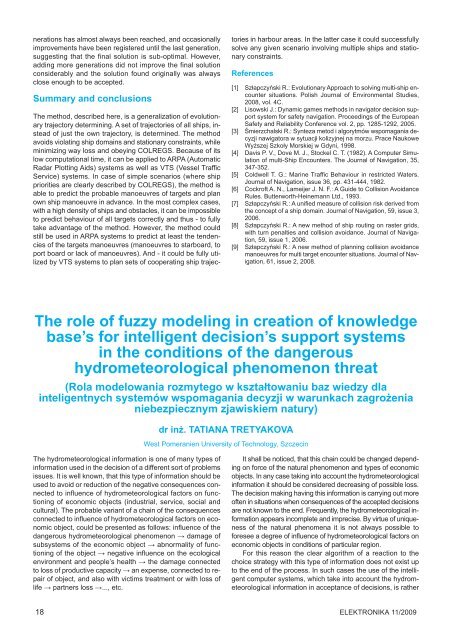Elektronika 2009-11.pdf - Instytut Systemów Elektronicznych
Elektronika 2009-11.pdf - Instytut Systemów Elektronicznych
Elektronika 2009-11.pdf - Instytut Systemów Elektronicznych
Create successful ePaper yourself
Turn your PDF publications into a flip-book with our unique Google optimized e-Paper software.
nerations has almost always been reached, and occasionally<br />
improvements have been registered until the last generation,<br />
suggesting that the final solution is sub-optimal. However,<br />
adding more generations did not improve the final solution<br />
considerably and the solution found originally was always<br />
close enough to be accepted.<br />
Summary and conclusions<br />
The method, described here, is a generalization of evolutionary<br />
trajectory determining. A set of trajectories of all ships, instead<br />
of just the own trajectory, is determined. The method<br />
avoids violating ship domains and stationary constraints, while<br />
minimizing way loss and obeying COLREGS. Because of its<br />
low computational time, it can be applied to ARPA (Automatic<br />
Radar Plotting Aids) systems as well as VTS (Vessel Traffic<br />
Service) systems. In case of simple scenarios (where ship<br />
priorities are clearly described by COLREGS), the method is<br />
able to predict the probable manoeuvres of targets and plan<br />
own ship manoeuvre in advance. In the most complex cases,<br />
with a high density of ships and obstacles, it can be impossible<br />
to predict behaviour of all targets correctly and thus - to fully<br />
take advantage of the method. However, the method could<br />
still be used in ARPA systems to predict at least the tendencies<br />
of the targets manoeuvres (manoeuvres to starboard, to<br />
port board or lack of manoeuvres). And - it could be fully utilized<br />
by VTS systems to plan sets of cooperating ship trajectories<br />
in harbour areas. In the latter case it could successfully<br />
solve any given scenario involving multiple ships and stationary<br />
constraints.<br />
References<br />
[1] Szłapczyński R.: Evolutionary Approach to solving multi-ship encounter<br />
situations. Polish Journal of Environmental Studies,<br />
2008, vol. 4C.<br />
[2] Lisowski J.: Dynamic games methods in navigator decision support<br />
system for safety navigation. Proceedings of the European<br />
Safety and Reliability Conference vol. 2, pp. 1285-1292, 2005.<br />
[3] Śmierzchalski R.: Synteza metod i algorytmów wspomagania decyzji<br />
nawigatora w sytuacji kolizyjnej na morzu. Prace Naukowe<br />
Wyższej Szkoły Morskiej w Gdyni, 1998.<br />
[4] Davis P. V., Dove M. J., Stockel C. T. (1982). A Computer Simulation<br />
of multi-Ship Encounters. The Journal of Navigation, 35,<br />
347-352.<br />
[5] Coldwell T. G.: Marine Traffic Behaviour in restricted Waters.<br />
Journal of Navigation, issue 36, pp. 431-444, 1982.<br />
[6] Cockroft A. N., Lameijer J. N. F.: A Guide to Collision Avoidance<br />
Rules. Butterworth-Heinemann Ltd., 1993.<br />
[7] Szłapczyński R.: A unified measure of collision risk derived from<br />
the concept of a ship domain. Journal of Navigation, 59, issue 3,<br />
2006.<br />
[8] Szłapczyński R.: A new method of ship routing on raster grids,<br />
with turn penalties and collision avoidance. Journal of Navigation,<br />
59, issue 1, 2006.<br />
[9] Szłapczyński R.: A new method of planning collision avoidance<br />
manoeuvres for multi target encounter situations. Journal of Navigation,<br />
61, issue 2, 2008.<br />
The role of fuzzy modeling in creation of knowledge<br />
base’s for intelligent decision’s support systems<br />
in the conditions of the dangerous<br />
hydrometeorological phenomenon threat<br />
(Rola modelowania rozmytego w kształtowaniu baz wiedzy dla<br />
inteligentnych systemów wspomagania decyzji w warunkach zagrożenia<br />
niebezpiecznym zjawiskiem natury)<br />
dr inż. TATIANA TRETYAKOVA<br />
West Pomeranien University of Technology, Szczecin<br />
The hydrometeorological information is one of many types of<br />
information used in the decision of a different sort of problems<br />
issues. It is well known, that this type of information should be<br />
used to avoid or reduction of the negative consequences connected<br />
to influence of hydrometeorological factors on functioning<br />
of economic objects (industrial, service, social and<br />
cultural). The probable variant of a chain of the consequences<br />
connected to influence of hydrometeorological factors on economic<br />
object, could be presented as follows: influence of the<br />
dangerous hydrometeorological phenomenon → damage of<br />
subsystems of the economic object → abnormality of functioning<br />
of the object → negative influence on the ecological<br />
environment and people’s health → the damage connected<br />
to loss of productive capacity → an expense, connected to repair<br />
of object, and also with victims treatment or with loss of<br />
life → partners loss →..., etc.<br />
It shall be noticed, that this chain could be changed depending<br />
on force of the natural phenomenon and types of economic<br />
objects. In any case taking into account the hydrometeorological<br />
information it should be considered decreasing of possible loss.<br />
The decision making having this information is carrying out more<br />
often in situations when consequences of the accepted decisions<br />
are not known to the end. Frequently, the hydrometeorological information<br />
appears incomplete and imprecise. By virtue of uniqueness<br />
of the natural phenomena it is not always possible to<br />
foresee a degree of influence of hydrometeorological factors on<br />
economic objects in conditions of particular region.<br />
For this reason the clear algorithm of a reaction to the<br />
choice strategy with this type of information does not exist up<br />
to the end of the process. In such cases the use of the intelligent<br />
computer systems, which take into account the hydrometeorological<br />
information in acceptance of decisions, is rather<br />
18 ELEKTRONIKA 11/<strong>2009</strong>

















